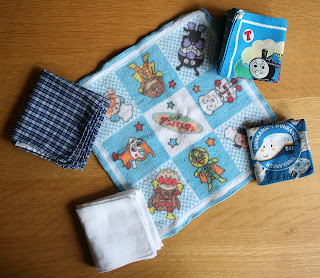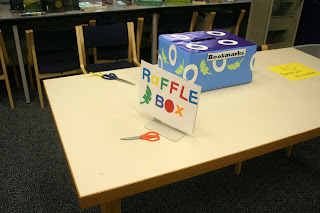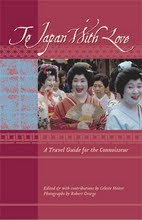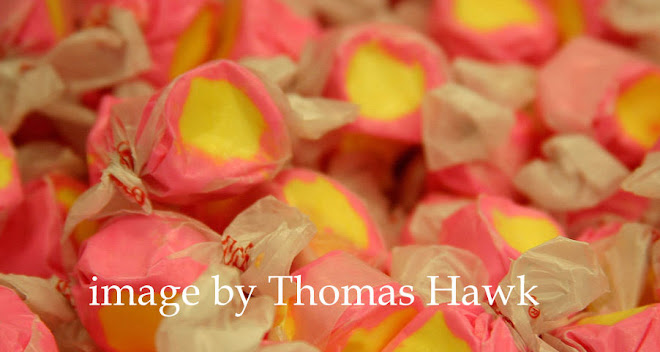April 30, 2007
Clean Campaign
This poster was near the entrance of a small train station. It encourages people to remember their manners and not leave their bicycles near the station.
This is a close-up of the poster. (I brightened it a little.) A sakura blossom is being crushed by a bicycle tire. Sakura is a symbol of spring, of new beginnings. Papa says sakura is the heart of Japan. Maybe other Japanese people feel the same way.
Check the labels below or do a blog search for other clean campaigns and recycling. If this is your visit to this blog, check March and April posts for more pictures of sakura trees and sakura products.
Posted by
Annie Donwerth Chikamatsu
at
8:40 PM
0
comments
![]()
Labels: environment, recycling, sakura
April 29, 2007
Handkerchiefs
Handkerchiefs are needed at school because there are no paper towels in the restrooms. (Some public rest rooms now have paper towels.) The Thomas and the Shinkansen, Japanese bullet train, handkerchiefs were Little Brother's in kindergarten. The one laying flat has characters from a cartoon about Anpanman (bean paste bread man). Little Brother carried that one in kindergarten, too. It's a terrycloth towel. He carries the plaid one and others like it now in elementary school. The white one is for funerals.
Posted by
Annie Donwerth Chikamatsu
at
9:53 PM
0
comments
![]()
April 28, 2007
Even the Onions Bow
Maybe this is a haiku moment.
Patricia Donegan points out in in her book, Haiku, that Basho, a Japanese haiku master, said, "Follow nature and return to nature" and "Learn about the pine from the pine and learn about the bamboo from the bamboo." And onions from onions, too, I guess.
Posted by
Annie Donwerth Chikamatsu
at
11:00 AM
0
comments
![]()
Labels: plants
April 27, 2007
Haiku
Little Brother and Big Sister have written Japanese haiku in school. We just discovered a book in English called Haiku, Asian Arts & Crafts for Creative Kids by Patricia Donegan. As you can see, the subtitle is learn to express yourself by writing poetry in the Japanese tradition. Patricia Donegan studied with Japanese haiku master Seishi Yamaguchi. She has also written other poetry books. She teaches at a university in Tokyo.
Her book introduces haiku as a way of "pausing to notice". She says to "learn to see the world through 'haiku eyes'". She also talks about "haiku moments". She gives seven keys to writing haiku, many examples, and exercises for practice. She also explains haibun (story with haiku), haiga (drawing & haiku) and renga (linked poetry). She gives a season dictionary, instructions on making a small book, and lists of links for websites, magazines, contests and haiku societies. The book is written for kids but adults can use it, too.
The book is part of a series of books with hands-on projects from Asia. Patricia Donegan's book was published in 2003. The series is published by Tuttle Publishing.
Posted by
Annie Donwerth Chikamatsu
at
8:03 PM
0
comments
![]()
Labels: books
April 26, 2007
Reading Aloud Every Night
At our neighborhood elementary school, students in every grade have to read aloud from their textbook every night. They fill in a chart like this one. First, the date and the title of the piece is filled in. A parent has to mark their performance as "good", "so-so", "needs more work" (that's a rough translation). Little Brother's performance was marked "good". The parent signs it. The next day, the teacher checks the card and puts a sticker next to the parent's signature. Little Brother has a reading card for this year, too. There more things to check in his performance. In first grade, the card had more details to fill in, too.
Students have time for free reading before class starts in the morning. As they are waiting for lunch to be served, they have free reading time. They can take a book from home or go to the school library to check one out.
Posted by
Annie Donwerth Chikamatsu
at
8:52 PM
0
comments
![]()
Labels: school, school work
Fifth Grade Reading Test
This is one of Little Brother's reading tests. He had a hard time finding one with a mistake on it! Can you find the mistake? Click on the picture to enlarge it.
Circles are written on correct answers. Triangles are written on wrong answers. He had to read the article and then answer questions.
Posted by
Annie Donwerth Chikamatsu
at
8:43 PM
0
comments
![]()
Labels: school, school work
April 25, 2007
The Sakura Medal
Soon, the Sakura Medal will be awarded to a picture book and a chapter book. Students at some of the international elementary schools in Japan are voting for their favorite picture books and chapter books this week.
Librarians and teachers from participating international schools selected the books. Here are some of the books that were nominated. These pictures were taken at the American school.
The authors of the winning books will receive a medal, a certificate, and an original work of art. Students painted pictures as part of the "Sakura Medal Art Project". The certificate and a copy of the art are placed in a nice black cover. This rocking chair, however, stays there. It was given to the American School Elementary School Library. A librarian sits in it at storytime. The kids sit on the floor.
Here is the "Sakura Medal Art Project" at the American School. These pictures are voted on, too. Unfortunately, I didn't take a close-up. The theme was a Japanese setting with sakura, cherry blossoms.
This is the wall of pockets at the American School. Each elementary school student has a pocket on this wall. In October, students started reading the books on the Sakura Medal list. they read other books as well. The selection for the medal is also part of a reading incentive. Students are encouraged to read as many books as they can. The students put a slip of paper in their pockets when they finished a book. Some students got to attend some special activities based on how many books they had read.
On voting day, students decide which book they liked the most and then vote. The votes are counted and tallied from all of the other schools. The results may be in next week. I'll post them.
At the American School, there was also a raffle. Oops! I forgot to ask what the prize is! I'll tell you when I post the winners of the medal.
There was a table of snacks for voters.
Picture Books nominated for the Sakura Medal 2007
Chapter Books nominated for the Sakura Medal 2007
High school students will also choose their favorite book. A Sakura Medal will also be awarded to the favorite Japanese book.
Posted by
Annie Donwerth Chikamatsu
at
4:20 PM
0
comments
![]()
Labels: authors, books, Sakura Medal
April 24, 2007
Contact Notebook
This notebook is sometimes used for writing down assignments or announcements, but it is also used for communication with the teacher. When a student is absent, a parent must write a message to the teacher in this notebook. At Little Brother's school the notebook is then put in this zippered pouch and taken by a classmate to the teacher. This notebook, homework assignments, worksheets or handouts are put in the pouch and taken back to the absent student. Textbooks are kept at home.
Posted by
Annie Donwerth Chikamatsu
at
11:54 PM
0
comments
![]()
Labels: school, school items
Class Notebooks
This is one of Little Brother's notebooks. Many designs are available. This one supports UNICEF.
Some notebooks have marks on them. The triangle and the hands that form the "e" tells that the notebook is kind to the environment. Bell marks are collected by schools to get money for equipment. Do a blog search of "bell mark" for more information.
There are different notebooks for different subjects. The 5mm masu is the size of the squares in this notebook.
This is one of Little Brother's fifth grade science notebooks. A teacher's handout was glued on one end of a page.
Posted by
Annie Donwerth Chikamatsu
at
11:53 PM
0
comments
![]()
Labels: environment, school
April 23, 2007
Fifth Grade Japanese Class
Little Brother had Japanese class every day last year (see the schedule posted on April 18). These were his kanji books. Each book had a chart of new kanji in the back. There were a total of 156 in these fifth grade books. Click to enlarge the picture to get a closer look. Some exercises were written in the textbook.
Some Japanese language exercises were done in a notebook. On this page, Little Brother numbered and wrote the answers vertically, from top to bottom. Note that he started from the outside of the page and worked his way to the center of the notebook. # 1 through 4 are on the left near the edge of the page. #20 is near the center of the book.
This type of paper is used when practicing how to write kanji. The dotted lines within the square help the student know how big to make the strokes and where to put them.
They can also use notebooks with paper like this.
Students put a plastic sheet under the paper so that there is no imprint on the other pages in the notebook.
Kids Web Japan-- kanji
Posted by
Annie Donwerth Chikamatsu
at
10:09 PM
0
comments
![]()
Labels: school, school items, school work
April 22, 2007
Earth Day 2007: Another Trip to Jindai Botanical Gardens
Hopped on a bus to go to Jindai Botanical Gardens again. This time for the azaleas. We didn't have to hop up too far--the bus driver pushed a button and whoosh! The bus bent down for us.
Here is the map at the entrance of the Gardens. The pictures on the left show what is in bloom now.
We go to Jindai Botanical Gardens to enjoy the seasons of plants. Check out all the pictures posted today.
If you are interested in Japanese gardens, have a look at the new book, Create Your Own Japanese Garden A Practical Guide written by Motomi Oguchi and Joseph Cali. Joseph Cali also wrote The New Zen Garden: Designing Quiet Places.
for info. about Earth Day:
Earth Day Tokyo in Japanese
Earth Day
The Wilderness Society
Jindai Botanical Gardens
Posted by
Annie Donwerth Chikamatsu
at
3:00 PM
0
comments
![]()
Labels: garden, Jindai Botanical Gardens
Azaleas at Jindai Botanical Gardens
After breathing all those bus fumes, it was nice to see the many azaleas. They are supposed to clean the air. This is the view from across the pond.
The azaleas were not in full bloom. Some of these shrubs are rhododendron. They will bloom later.
On the other side of the pond.
Jindai Botanical Garden
Posted by
Annie Donwerth Chikamatsu
at
2:59 PM
0
comments
![]()
Labels: flowers, garden, Jindai Botanical Gardens
Some Trees at Jindai Botanical Gardens
Trees clean the air, too. Early spring and the pine cones are forming.
The cherry trees are now green with leaves. This one needs support.
Jindai Botanical Gardens
Posted by
Annie Donwerth Chikamatsu
at
2:58 PM
0
comments
![]()
Labels: garden, Jindai Botanical Gardens, trees
Wisteria
Wisteria needs support, too. This one hasn't begun to bloom.
This is what the blooms look like before they open. These will be purple.
Here's one that is getting a lot of attention. It was beautiful. It's not a very good picture, though. The camera was focusing on the man in front.
Some wisteria are white.
Jindai Botanical Gardens
Posted by
Annie Donwerth Chikamatsu
at
2:57 PM
0
comments
![]()
Labels: flowers, Japanese wisteria, Jindai Botanical Gardens, plants, wisteria
Wisteria Lane
Here is a purple wisteria blossom in full bloom.
Maybe in a week or so this wisteria will all be in bloom.
This is the base of the vine.
Posted by
Annie Donwerth Chikamatsu
at
2:56 PM
0
comments
![]()
Labels: flowers, Japanese wisteria, Jindai Botanical Gardens, plants, wisteria
Plant Supports
There will be a new section of plants. Men were building supports for them. They used bamboo poles.
Bamboo is very strong. When I lived in Malaysia in the 1980s, it was used as scaffolding for constructing tall buildings.
Posted by
Annie Donwerth Chikamatsu
at
2:55 PM
0
comments
![]()
Labels: garden, Jindai Botanical Gardens































































